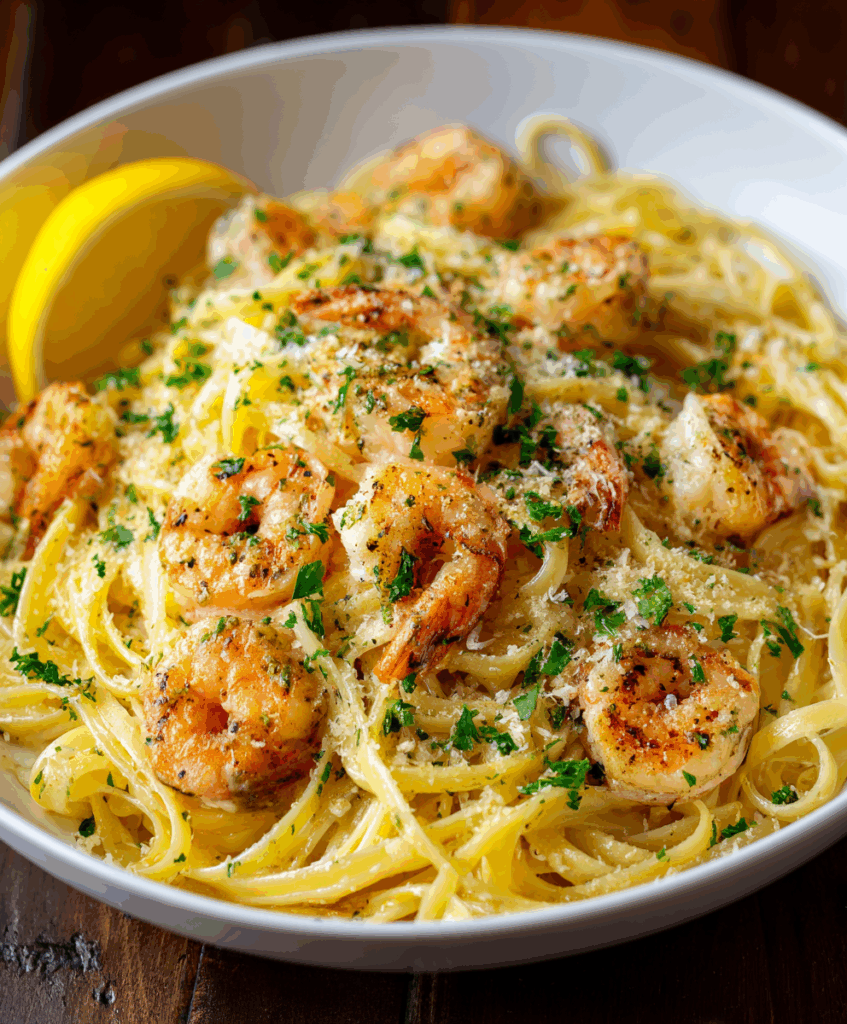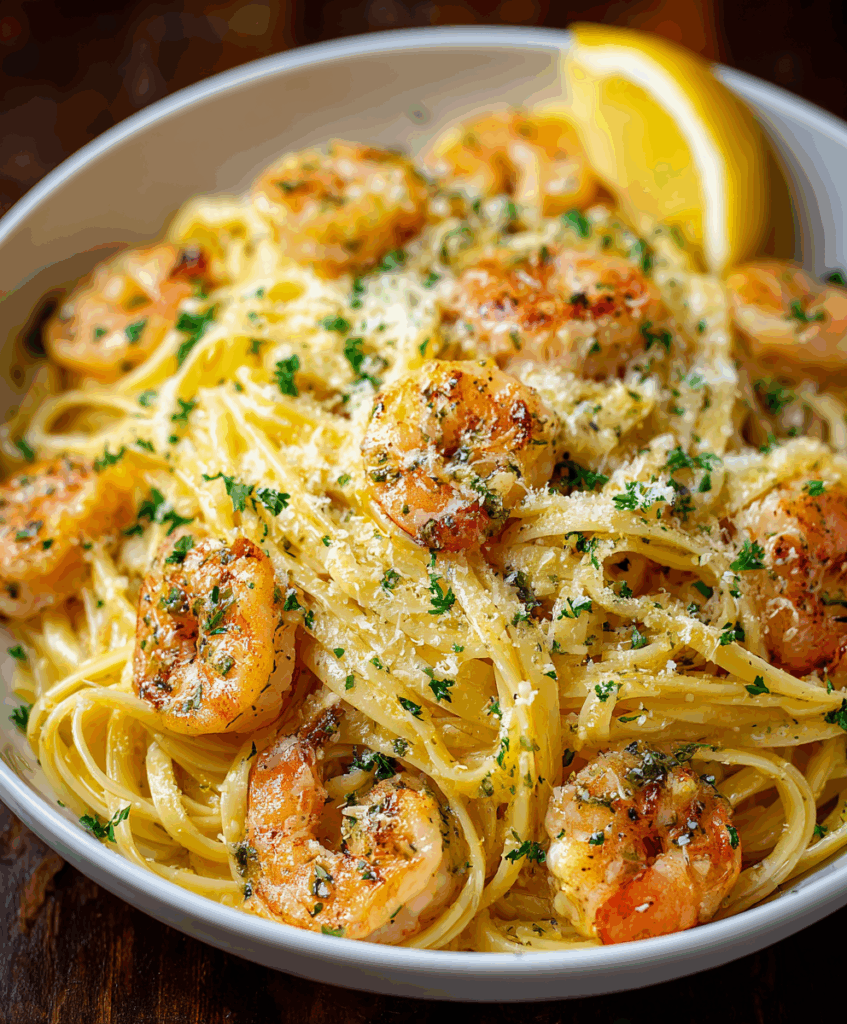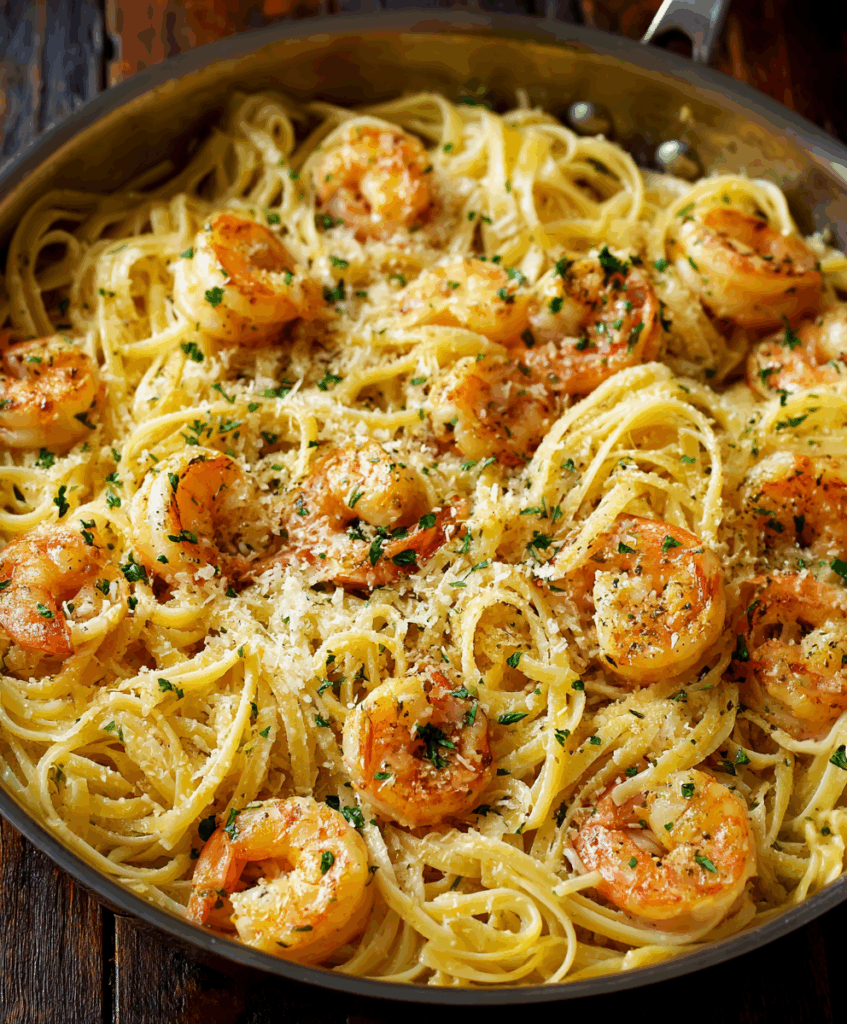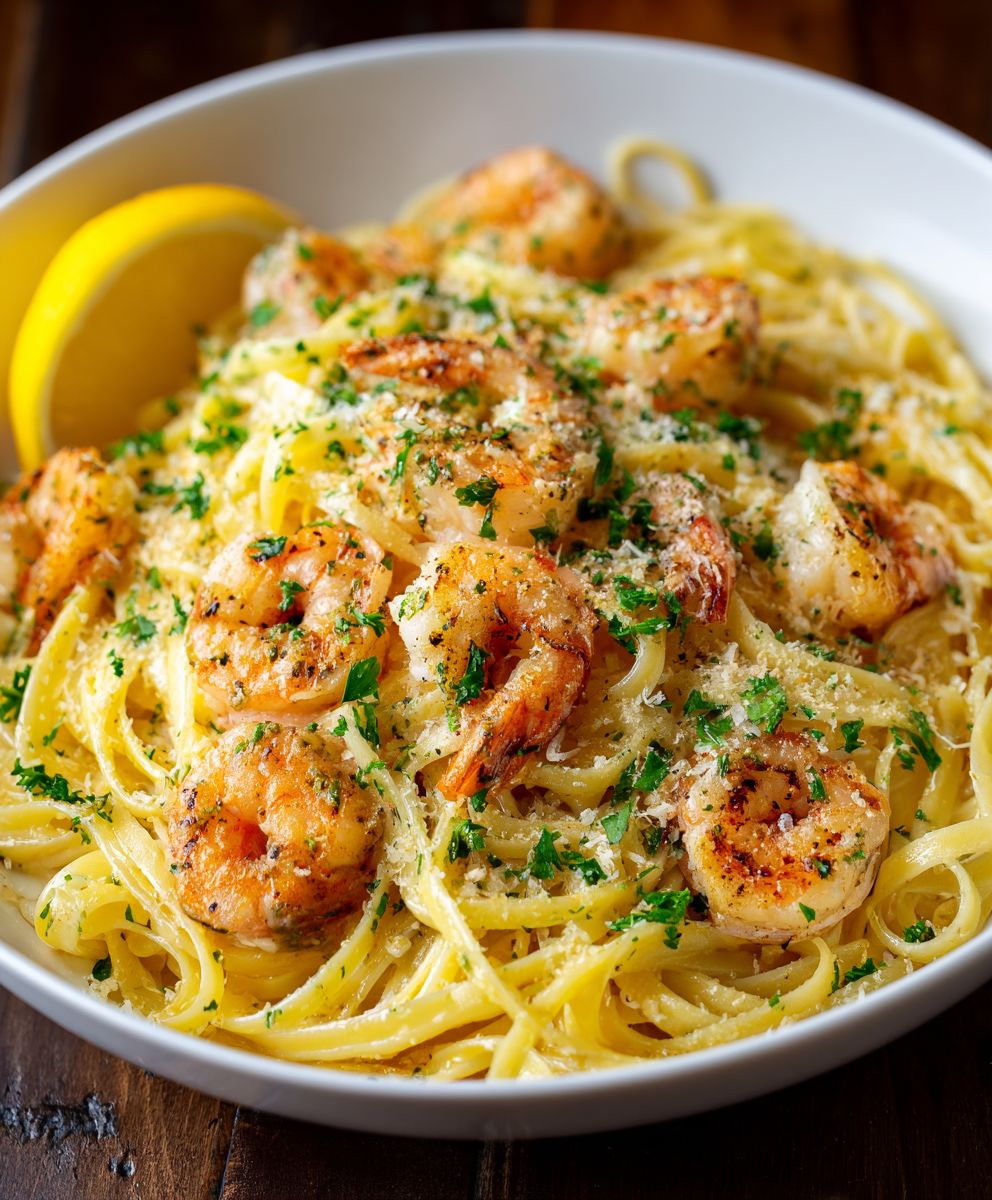Garlic Cream Shrimp Linguine
Creamy garlic shrimp linguine with Parmesan, herbs, and a silky sauce—restaurant comfort made fast for weeknights or date nights.

Butter, olive oil, and plenty of garlic set the tone; then come juicy shrimp and a lush cream sauce that clings to every strand of pasta. A pinch of chili heat keeps things lively, Parmesan adds savory depth, and fresh parsley brightens the finish. It’s rich without feeling heavy, indulgent without fuss, and on the table in under half an hour.
The flow is easy: sear shrimp for sweet, golden edges, build the sauce right in the same pan, then toss with hot pasta and a splash of starchy water for that glossy, trattoria-style sheen. Gather bowls—this one disappears quickly.
What You Need to Make This Garlic Cream Shrimp Linguine
- Linguine or spaghetti — Long strands that capture creamy sauce in every twist.
- Large shrimp (peeled & deveined) — Quick-cooking, sweet, and plump; the star protein.
- Butter & olive oil — Flavor and searing power with a little richness.
- Garlic — Four cloves for aromatic backbone.
- Heavy cream — Silky body that reduces to a luxurious gloss.
- Chicken broth or pasta water — Loosens and balances richness while carrying flavor.
- Parmesan — Nutty savor that melts into the sauce.
- Italian seasoning & red pepper flakes — Herby warmth and optional heat.
- Salt & black pepper — Essential seasoning in layers.
- Fresh parsley — Bright finish for color and freshness.
Step-by-Step Garlic Cream Shrimp Linguine
STEP 1: Bring a large pot of well-salted water to a boil and cook linguine until al dente. Reserve about ½ cup of the starchy cooking water before draining so the sauce can be adjusted to a silky consistency later.
STEP 2: Heat butter and olive oil in a large skillet over medium heat. Pat shrimp dry, season with salt and pepper, and lay them in a single layer. Sear 1–2 minutes per side until just pink and opaque with lightly golden edges. Transfer to a plate to keep them tender.
STEP 3: In the same skillet, drop the heat slightly and add the minced garlic. Stir 30 seconds until fragrant—avoid browning. Pour in the cream and broth (or a splash of pasta water), then stir in Parmesan, Italian seasoning, and red pepper flakes.
STEP 4: Simmer 3–4 minutes, stirring, until the sauce thickens to a spoon-coating consistency. If it looks too tight, whisk in a little reserved pasta water; if too loose, let it bubble gently another minute.
STEP 5: Add the drained pasta and the cooked shrimp back to the skillet. Toss to coat, letting the sauce cling to the noodles. Adjust salt and pepper to taste and finish with chopped parsley and a touch more Parmesan.
STEP 6: Plate immediately while glossy and hot. A final flick of red pepper flakes or a squeeze of lemon (optional) brightens the richness right at the table.
Using frozen shrimp without compromise
Frozen shrimp often taste fresher than “fresh” seafood that’s been previously frozen. Thaw in a colander under cold running water, then pat very dry so the shrimp sear instead of steam. Dry surfaces pick up light caramelization, which deepens flavor and helps the sauce taste fuller with minimal effort.

Preventing a broken cream sauce
Gentle heat is the safeguard. After searing shrimp, lower the flame before adding cream and cheese, and keep the sauce at a friendly simmer—not a rapid boil. Parmesan should be added gradually and whisked until smooth; sudden high heat or prolonged boiling can cause splitting and a grainy texture.
Balancing sauce thickness the right way
Starchy pasta water is the built-in magic wand. A tablespoon or two loosens a sauce that’s reduced a hair too far, restoring silkiness without thinning flavor. When the sauce feels loose, a minute of gentle simmering tightens it. Aim for a glossy coat that clings to noodles rather than pooling on the plate.
Smart pasta swaps for texture and bite
Linguine is classic, but fettuccine offers broader ribbons for extra sauce cling, and spaghetti gives a springier bite. Short shapes (penne, rigatoni) work in a pinch, though they feel heartier and less “seafood trattoria.” Use what’s on hand—just cook to al dente so the pasta finishes perfectly in the pan.
Lighter and dairy-free pathways
Half-and-half softens richness with a slightly thinner but still lovely sauce; simmer gently to avoid curdling. For dairy-free, use a rich unsweetened oat or cashew cream and a plant-based Parmesan-style crumble. The texture stays plush, and a squeeze of lemon compensates for the missing dairy tang.
Pro Tips for Garlic Cream Shrimp Linguine
- Dry shrimp = better sear: Moisture prevents browning; pat thoroughly before the pan.
- Grate cheese fresh: Pre-shredded Parmesan contains starches that can make sauces grainy.
- Finish in the skillet: Tossing pasta in the sauce for a minute merges starch and fat into a restaurant-quality gloss.

What to Serve with Garlic Cream Shrimp Linguine
- Crisp green salad with lemon vinaigrette to cut through richness.
- Roasted asparagus or broccolini for a tender, slightly charred counterpoint.
- Warm crusty bread to swipe up every last ribbon of sauce.
Storage & Reheating
Refrigerate leftovers in an airtight container for up to 2 days. Reheat gently in a skillet over low heat with a splash of water or milk to loosen the sauce; avoid boiling to keep shrimp tender and the cream smooth. Freezing isn’t ideal—shrimp can toughen and cream sauces may separate after thawing—so enjoy this one fresh when possible.

Garlic Cream Shrimp Linguine
Ingredients
- 2 tablespoons unsalted butter
- 1 cup 240 ml full-fat heavy cream
- ½ cup 50 g finely grated Parmesan
- 4 garlic cloves finely minced
- 1 teaspoon dried Italian herb blend
- 1 tablespoon extra virgin olive oil
- ½ cup 120 ml low-sodium chicken stock or reserved pasta cooking liquid
- 8 ounces 225 g linguine or spaghetti noodles
- 1 pound 450 g large shrimp, peeled and deveined
- ¼ teaspoon crushed red chili flakes optional, for spice
- Salt and ground black pepper to preference
- 2 tablespoons chopped flat-leaf parsley for garnish
Instructions
- Fill a large saucepan with water, add a generous pinch of salt, and bring to a boil. Cook the pasta following the package guidelines until al dente. Drain well, reserving approximately half a cup of the starchy cooking water.
- In a wide skillet set over medium heat, combine the butter with the olive oil. Once melted and hot, arrange the shrimp in a single layer. Season lightly with salt and pepper. Sauté for 1 to 2 minutes on each side until the shrimp are opaque and just cooked through. Transfer to a separate plate.
- Using the same pan, add the minced garlic and sauté briefly for about 30 seconds, just until aromatic.
- Stir in the heavy cream and chicken broth (or reserved pasta water). Add the grated Parmesan, Italian seasoning, and red pepper flakes. Allow the mixture to gently simmer for 3 to 4 minutes, stirring occasionally, until the sauce begins to thicken.
- Return the drained pasta and seared shrimp to the skillet. Gently toss everything together until coated evenly in the cream sauce. If the mixture appears too thick, stir in a splash of reserved pasta water to loosen it to your preferred consistency.
- Finish by sprinkling over the chopped parsley and, if desired, a little more grated Parmesan. Serve the dish hot, directly from the pan or plated individually.
